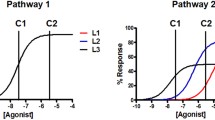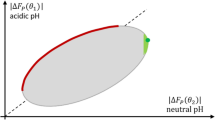Abstract
Two chemical function-based pharmacophore models of selective κ-opioid receptor agonists were generated by using two different programs: Catalyst/HypoGen and Phase. The best output hypothesis (Hypo1) of HypoGen consisted of five features: one hydrogen-bond acceptor (HA), three hydrophobic points (HY), and one positive ionizable function (PI). The highest scoring model (Hypo2) produced by Phase comprised four features: one acceptor (A), one positive ionizable function (P), and two aromatic ring features (R). These two models (Hypo1 and Hypo2) were then validated by test set prediction and enrichment factors. They were shown to be able to identify highly potent κ-agonists within a certain range, and satisfactory enrichments were achieved. The features of these two pharmacophore models were similar and consistent with experiment data. The models produced here were also generally in accord with other reported models. Therefore, our pharmacophore models were considered as valuable tools for 3D virtual screening, and could be useful for designing novel κ-agonists.





Similar content being viewed by others
References
Schwalbe H, Wess G (2002) Chem Bio Chem 3:915–919. doi:10.1002/1439-7633(20021004)3:10<915::AID-CBIC915>3.0.CO;2-L
Gether U (2000) Endocr Rev 21:90–113. doi:10.1210/er.21.1.90
Ulloa-Aguirre A, Stanislaus D, Janovick JA, Conn PM (1999) Arch Med Res 30:420–435. doi:10.1016/S0188-0128(99)00041-X
Kieffer BL (1995) Cell Mol Neurobiol 15:615–635. doi:10.1007/BF02071128
Dhawan BN, Cesselin F, Raghubir R, Reisine T, Bradley PB, Portoghese PS, Hamon M (1996) Pharmacol Rev 48:567–592
DeHaven-Hudkins DL, Dolle RE (2004) Curr Pharm Des 10:743–757. doi:10.2174/1381612043453036
Holzgrabe U, Brandt W (2003) J Med Chem 46:1383–1389. doi:10.1021/jm0210360
Soukara S, Maier CA, Predoiu U, Ehret A, Jackisch R, Wunsch B (2001) J Med Chem 44:2814–2826. doi:10.1021/jm0108395
Szmuszkovicz J, Von Voigtlander PF (1982) J Med Chem 25:1125–1126. doi:10.1021/jm00352a005
Costello GF, James R, Shaw JS, Slater AM, Stutchbury NCJ (1991) J Med Chem 34:181–189. doi:10.1021/jm00105a027
Chu GH, Gu M, Cassel JA, Belanger S, Graczyk TM, DeHaven RN, Conway-James N, Koblish M, Little PJ, DeHaven-Hudkins DL, Dolle RE (2007) Bioorg Med Chem Lett 17:1951–1955. doi:10.1016/j.bmcl.2007.01.053
Chu GH, Gu M, Cassel JA, Belanger S, Stabley GJ, DeHaven RN, Conway-James N, Koblish M, Little PJ, DeHaven-Hudkins DL, Dolle RE (2006) Bioorg Med Chem Lett 16:645–648. doi:10.1016/j.bmcl.2005.10.034
Le Bourdonnec B, Ajello CW, Seida PR, Susnow RG, Cassel JA, Belanger S, Stabley GJ, DeHaven RN, DeHaven-Hudkins DL, Dolle RE (2005) Bioorg Med Chem Lett 15:2647–2652. doi:10.1016/j.bmcl.2005.03.020
Chu GH, Gu M, Cassel JA, Belanger S, Graczyk TM, DeHaven RN, Conway-James N, Koblish M, Little PJ, DeHaven-Hudkins DL, Dolle RE (2005) Bioorg Med Chem Lett 15:5114–5119. doi:10.1016/j.bmcl.2005.08.094
Kumar V, Guo D, Cassel JA, Daubert JD, Dehaven RN, Dehaven-Hudkins DL, Gauntner EK, Gottshall SL, Greiner SL, Koblish M, Little PJ, Mansson E, Maycock AL (2005) Bioorg Med Chem Lett 15:1091–1095. doi:10.1016/j.bmcl.2004.12.018
Tuthill PA, Seida PR, Barker W, Cassel JA, Belanger S, DeHaven RN, Koblish M, Gottshall SL, Little PJ, DeHaven-Hudkins DL, Dolle RE (2004) Bioorg Med Chem Lett 14:5693–5697. doi:10.1016/j.bmcl.2004.08.041
Kumar V, Marella MA, Cortes-Burgos L, Chang AC, Cassel JA, Daubert JD, DeHaven RN, DeHaven-Hudkins DL, Gottshall SL, Mansson E, Maycock AL (2000) Bioorg Med Chem Lett 10:2567–2570. doi:10.1016/S0960-894X(00)00519-9
Kurogi Y, Guner OF (2001) Curr Med Chem 8:1035–1055
Li H, Sutter J, Hoffman R, HypoGen (2000) An automated system for generating 3D predictive pharmacophore models. In: Guner O (ed) Pharmacophore perception, development and use in drug design. International University Line, La Jolla, CA
Dixon SL, Smondyrev AM, Knoll EH, Rao SN, Shaw DE, Friesner RA (2006) J Comput Aided Mol Des 20:647–671. doi:10.1007/s10822-006-9087-6
Phase 2.0, Schrodinger, LLC: New York
Fischer R (1966) The principle of experimentation, illustrated by a PSYcho-Physical Experiment. Hafner, New York, Chap. II
CATALYST 4.10, Accelrys, http://www.accelrys.com: San Diego, CA
Funk OF, Kettmann V, Drimal J, Langer T (2004) J Med Chem 47:2750–2760. doi:10.1021/jm031041j
Krovat EM, Langer T (2003) J Med Chem 46:716–726. doi:10.1021/jm021032v
Tafi A, Costi R, Botta M, Santo R, Corelli F, Massa S, Ciacci A, Manetti F, Artico M (2002) J Med Chem 45:2720–2732. doi:10.1021/jm011087h
Sybyl 7.0, Triops, St Louis, MO
Martin YC Distance comparisons (DISCO): a new strategy for examining 3D structure-activity relationships. American Chemical Society, Washington DC, 1995
Jones G, Willett P, Glen RC (1995) J Comput Aided Mol Des 9:532–549. doi:10.1007/BF00124324
Richmond NJ, Abrams CA, Wolohan PR, Abrahamian E, Willett P, Clark RD (2006) J Comput Aided Mol Des 20:567–587. doi:10.1007/s10822-006-9082-y
Ockham WO English philosopher and Franciscan Monk, 1285, see http://www.britannica.com/EBchecked/topic/424706/Ockhams-razor
de Costa BR, Bowen WD, Hellewell SB, George C, Rothman RB, Reid AA, Walker JM, Jacobson AE, Rice KC (1989) J Med Chem 32:1996–2002. doi:10.1021/jm00128a050
Halfpenny PR, Horwell DC, Hughes J, Hunter JC, Rees DC (1990) J Med Chem 33:286–291. doi:10.1021/jm00163a047
de Costa BR, Radesca L, Di Paolo L, Bowen WD (1992) J Med Chem 35:38–47. doi:10.1021/jm00079a004
Thirstrup K, Hjorth SA, Schwartz TW (1996) In: Investigation of the binding pocket in the kappa opioid receptor by a combination of alanine substitutions and steric hindrance mutagenesis. 27th Meeting of the International Narcotics Research Conference, poster M30, 21–26 July 1996, Long Beach, CA
Kong H, Raynor K, Reisine T (1994) Reg Pept 54:155–156. doi:10.1016/0167-0115(94)90437-5
Surratt CK, Johnson PS, Moriwaki A, Seidleck BK, Blaschak CJ, Wang JB, Uhl GR (1994) J Biol Chem 269:20548–20553
Uhl GR, Childers S, Pasternak G (1994) Trends Neurosci 17:89–93. doi:10.1016/0166-2236(94)90110-4
Lavecchia A, Greco G, Novellino E, Vittorio F, Ronsisvalle G (2000) J Med Chem 43:2124–2134. doi:10.1021/jm991161k
Singh N, Nolan TL, McCurdy CR (2008) J Mol Graph Model. doi:10.1016/j. jmgm.2008.03.007
Singh N, Cheve G, Mccurdy CR, Ferguson DM (2006) J Comput Aided Mol Des 20:471–493. doi:10.1007/s10822-006-9067-x
Flizola M, Villar HO, Loew GH (2001) J Comput Aided Mol Des 15:297–307. doi:10.1023/A:1011187320095
Acknowledgments
The authors greatly appreciate the software support for Catalyst from Prof. Hualiang Jiang of the Shanghai Institute of Materia Medica, CAS. This work was supported by National Natural Science Foundation of China (Grant 30600785), Shanghai Rising-Star Program (Grant 07QA14016), and Key 863 High-Tech Program (Grant 2006AA020404).
Author information
Authors and Affiliations
Corresponding author
Rights and permissions
About this article
Cite this article
Zhang, J., Liu, G. & Tang, Y. Chemical function-based pharmacophore generation of selective κ-opioid receptor agonists by catalyst and phase. J Mol Model 15, 1027–1041 (2009). https://doi.org/10.1007/s00894-008-0418-5
Received:
Accepted:
Published:
Issue Date:
DOI: https://doi.org/10.1007/s00894-008-0418-5




